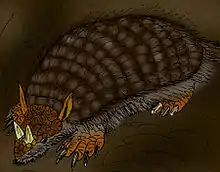Peltephilus
Peltephilus, the horned armadillo, is an extinct genus of armadillo xenarthran mammals that first inhabited Argentina during the Oligocene epoch, and became extinct in the Miocene epoch. Notably, the scutes on its head were so developed that they formed horns. Aside from the horned gophers of North America, it is the only known fossorial horned mammal.[1] P. ferox had skull about 11.7 centimetres (4.6 in),[2] and estimated body mass is around 11.07 kilograms (24.4 lb).[3]
| Peltephilus | |
|---|---|
 | |
| Interpretation of P. ferox | |
| Scientific classification | |
| Domain: | Eukaryota |
| Kingdom: | Animalia |
| Phylum: | Chordata |
| Class: | Mammalia |
| Order: | Cingulata |
| Family: | †Peltephilidae |
| Genus: | †Peltephilus Ameghino 1887 |
| Type species | |
| †Peltephilus ferox Ameghino 1887 | |
| Species | |
| |
Although it had traditionally been perceived as a carnivore because of its large, triangular-shaped teeth, Vizcaino and Farina argued in 1997 that Peltephilus was a herbivore.[4]
Taxonomy
The genus was originally classified as belonging to the family Chlamyphoridae, but in 2007 was placed in its own family Peltephilidae by Darin A. Croft, John J. Flynn and Andre Wyss.[5]
Distribution
Fossils of Peltephilus have been found in:[6]
- Argentina – Sarmiento Formation
- Bolivia – Salla Formation[7]
- Miocene
- Argentina – Colloncuran Collón Curá Formation and Santacrucian Santa Cruz Formation[8]
- Bolivia – Colloncuran Nazareno Formation
- Chile – Santacrucian Chucal Formation[5]
References
- Palmer, D., ed. (1999). The Marshall Illustrated Encyclopedia of Dinosaurs and Prehistoric Animals. London: Marshall Editions. pp. 208–209. ISBN 1-84028-152-9.
- Vlachos, Evangelos (2018). "A Review of the Fossil Record of North American Turtles of the Clade Pan-Testudinoidea". Bulletin of the Peabody Museum of Natural History. 59 (1): 3–94. doi:10.3374/014.058.0201. ISSN 0079-032X.
- Vizcaíno, Sergio F.; Fernicola, Juan C.; Bargo, M. Susana (2012), Bargo, M. Susana; Kay, Richard F.; Vizcaíno, Sergio F. (eds.), "Paleobiology of Santacrucian glyptodonts and armadillos (Xenarthra, Cingulata)", Early Miocene Paleobiology in Patagonia: High-Latitude Paleocommunities of the Santa Cruz Formation, Cambridge: Cambridge University Press, pp. 194–215, doi:10.1017/cbo9780511667381.013, ISBN 978-0-521-19461-7, retrieved 2023-05-22
- Vizcaino, S. F., & R. A. Farina (1997), Diet and locomotion of the armadillo Peltephilus: a new view. Lethaia, 30, 79-86.
- Croft et al., 2007
- Peltephilus at Fossilworks.org
- Shockey, 2017
- González Ruiz et al., 2013, p. 323
Bibliography
- Croft, Darin A.; Flynn, John J.; Wyss, André R. (2007). "A new basal Glyptodontid and other Xenarthra of the Early Miocene Chucal Fauna, northern Chile" (PDF). Journal of Vertebrate Paleontology. 21: 781–797. Retrieved 2017-08-15.
- González Ruiz, Laureano Raúl; Góis, Flavio; Ciancio, Martín Ricardo; Scillato Yané, Gustavo Juan (2013). "Los Peltephilidae (Mammalia, Xenarthra) de la Formación Collón Curá (Colloncurense, Mioceno Medio), Argentina" (PDF). Revista Brasileira de Paleontologia. 16: 319–330. Retrieved 2019-02-27.
- Shockey, Bruce J (2017). "New early diverging cingulate (Xenarthra: Peltephilidae) from the Late Oligocene of Bolivia and considerations regarding the origin of crown Xenarthra". Bulletin of the Peabody Museum of Natural History. 58 (2): 371–396. Retrieved 2019-02-12.

